

![]()
THE HERDING DOGS OF EUROPE AND ASIA
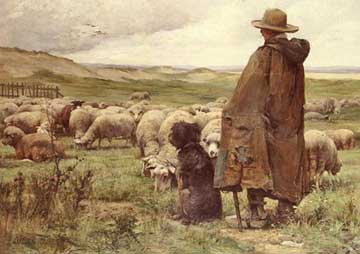
"Le Berger", a painting by French artist Jules Dupré (1811-1889)
of a shepherd and dog of the Berger de Crau type.
INTRODUCTION TO THE HERDING DOGS OF EUROPE AND ASIA
A great area of grassland known as the Eurasian Steppe stretches from the Danube River in the west to the Great Wall of China in the east, encompassing portions of Hungary, the Ukraine, southern Russia, Kazakhstan, Mongolia, and Manchuria. "Steppe" is a Russian word referring to a grassland or prairie without trees except for those that grow near rivers and lakes. The word actually means "wasteland", for that is what it seemed to those practicing agriculture. It is a semi-arid region with extremes of temperature, not just from summer to winter, but from day to night, with no trees to break the force of the wind.
The western portion of the Eurasian Steppe is often referred to as the Pontic-Caspian Steppe, as it encompasses a region of plains surrounding the northern ends of the Black and Caspian Seas. In this area, according to archaeologist J. P. Mallory, the "Proto-Indo-European [language] probably evolved out of the languages spoken by hunter-fishing communities... Settlement would have been confined primarily to the major river valleys and their tributaries", and it was here that the horse was domesticated, ca. 4000-3500 BC.
The domestication of the horse was the single, most important event to come out of the steppes and the Eneolithic Era (a.k.a., Copper Age). The horse allowed pastoral nomads to make full use of the Steppe. It made possible the herding of enormous flocks of sheep and other livestock over great distances. Nomadic pastoralism evolved with the need to search for fresh pastures. As archaeologist Elizabeth Wayland Barber says, "The first people to work out nomadism would have had such an edge over everyone else that they must have been the first to overrun their neighbors' pasturage".
The domestication of the dog is a much more complex subject, whose story is not yet finished being told. Remains of domesticated dogs were found in Siberia from approximately 33,000 years ago, but none of those lineages are thought to have survived the last Glacial Maximum (between 26,000-20,000 years ago). Current thinking places the present dog lineage as having been domesticated approximately 15,000 years ago, but advances in archaeological technology are beginning to push that date back. According to Elizabeth Pennisi, in a recent article in Science magazine, modern dogs have been shown to have a closer affinity to ancient wolves than to modern wolves and new DNA studies indicate that "dogs originated in Europe from a now-extinct branch of gray wolves". As in all things archaeological, findings such as these raise more questions than answers. Previous researchers found that genetic diversity in dogs is highest in East Asia, suggesting that dogs have been domesticated there the longest.
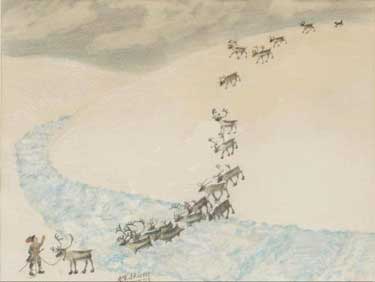 DNA evidence also shows that dogs of the northern breeds, such as reindeer herding dogs, belong to a group that shows a closer relationship to the modern wolf, suggesting that these breeds were produced by deliberately crossing already domesticated dogs with wild wolves. David Mech, a biologist and wolf ecologist, and others, have found that "although dogs and wolves are genetically very close and have shared vast portions of their ranges for millennia, the two do not voluntarily interbreed in the wild", therefore, these breedings were deliberate. Tests on dog bones from 4,000-5000 years ago show similarities between them and modern-day Japanese dogs, particularly the Shiba-Inu, a spitz-type dog.
DNA evidence also shows that dogs of the northern breeds, such as reindeer herding dogs, belong to a group that shows a closer relationship to the modern wolf, suggesting that these breeds were produced by deliberately crossing already domesticated dogs with wild wolves. David Mech, a biologist and wolf ecologist, and others, have found that "although dogs and wolves are genetically very close and have shared vast portions of their ranges for millennia, the two do not voluntarily interbreed in the wild", therefore, these breedings were deliberate. Tests on dog bones from 4,000-5000 years ago show similarities between them and modern-day Japanese dogs, particularly the Shiba-Inu, a spitz-type dog.
Left, a painting by Sami artist, Nils Nilsson Skum (1872-1951). The reindeer herder in the foreground is leading his herd across a river, with a lead reindeer in tow. In the distance you can see his spitz-type dog bringing up the rear. The herder is giving directions to the dog with hand signals.
Once agriculture took hold, and dogs were selected by man for a variety of tasks, their wolf-like natures may have become a liability for particular tasks, like herding. So, although there are still some herding breeds that are purported to have been bred back to wolves in recent times, it seem likely that characteristics we most associate with wolves would have been selected against. These topics are still the subject of research and discussion and, although the complete dog genome has been mapped, it may be many years before we know the actual origin and lineage of all domestic dogs.
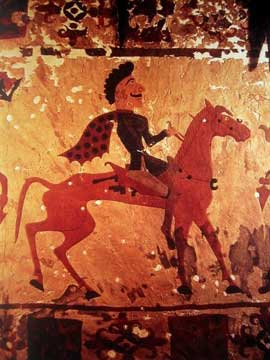 Starting nearly 3,000 years ago at the beginning of the first millennium BC, the Eurasian Steppe witnessed a long series of nomadic empires. However, the terms used to characterize them (e.g., "Scythian", "Saka", "Huns", "Mongolian") were broad and used to "describe a whole host of otherwise unrelated peoples sharing only certain similarities in lifestyle (i.e., nomadism)". The Greeks called all steppe nomads Scythians, which is why there is confusion. In fact, they were confederations of nomadic tribes. As each nomadic empire formed from the tribes of a particular area, they overwhelmed their neighbors, absorbed them into their own communities, or pushed them into other, less favorable areas. Then, as empires dissolved, the tribes that formed them went their separate ways. Some groups joined with more settled communities, or took them over, or usurped their territories and drove them into more remote regions. Today there are literally hundreds of small ethnic groups in Northern Asia, many of them remnants of migrations that took place over thousands of years, many of them as separate in their culture from one another as they are from the majority population of their country.
Starting nearly 3,000 years ago at the beginning of the first millennium BC, the Eurasian Steppe witnessed a long series of nomadic empires. However, the terms used to characterize them (e.g., "Scythian", "Saka", "Huns", "Mongolian") were broad and used to "describe a whole host of otherwise unrelated peoples sharing only certain similarities in lifestyle (i.e., nomadism)". The Greeks called all steppe nomads Scythians, which is why there is confusion. In fact, they were confederations of nomadic tribes. As each nomadic empire formed from the tribes of a particular area, they overwhelmed their neighbors, absorbed them into their own communities, or pushed them into other, less favorable areas. Then, as empires dissolved, the tribes that formed them went their separate ways. Some groups joined with more settled communities, or took them over, or usurped their territories and drove them into more remote regions. Today there are literally hundreds of small ethnic groups in Northern Asia, many of them remnants of migrations that took place over thousands of years, many of them as separate in their culture from one another as they are from the majority population of their country.
Left, a Pazyryk horseman ca. 300 BCE. Detail from a felt carpet that resides in the Hermitage Museum in St. Petersburg, Russia. The Pazyryk were a nomadic group from the Altai region of the Eurasian Steppe. They are known from their burial mounds or kurgans, which contained many felt artifacts including this one. It is thought that they were part of the Saka confederation. (Photo in the public domain.)
Many if not most of these groups maintain some form of pastoralism, though some of them are no longer nomadic. Those that still are have had their way of life greatly curtailed due to forced settlement in Eastern Europe and Asia when the Communists came to power or due to a drastic reduction in their nomadic routes when boundaries were drawn or administrative units were redefined by their governments. Agriculture and industrialization has further impinged upon their lifestyles. Today, many of these peoples' languages are endangered or extinct, and, in too many cases, the people along with them. When a people becomes extinct, it does not necessarily mean that there are no remaining members of their genetic group like it does for species of animals that go extinct, because all humans are the same species. It usually means that their language is no longer spoken, their culture is no longer practiced, and they themselves, if still living, have been culturally assimilated into other surrounding groups. This is similar to what often happens to immigrant communities in their adoptive countries today, and to minority groups everywhere.
In Europe, this process is not as clear as it is in Asia because there are many more smaller nations that have absorbed the various ethnic groups within their borders and have closed their borders to nomadism, and the distinctions among smaller ethnic groups began to be blurred. It is unlikely that true nomadism has actually been practiced in Europe since the modern era, the period that marked the end of the Middle Ages, except perhaps by Romany people, and in the case of the Romany, they were not necessarily pastoral. It is estimated that there still are thirty- to forty-million nomadic pastoralists in the world today, however, most are found in central Asia and the Sahel region of West Africa.
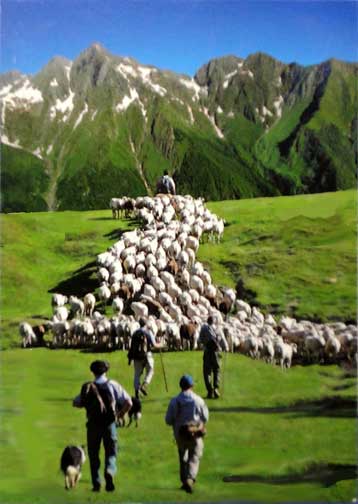 The difference between nomadism and transhumance is that in nomadism the entire population (which may be a single family, an extended family, a whole clan, or more) moves with the herd, taking their homes (yurts, tents, wagons, etc.) with them. In transhumance, only a shepherd or shepherds accompany the flock on a long migration, usually from the plains or steppes to the mountains, and back again. The rest of the population remains stationary at home. According to the Maison de la Transhumance, transhumance makes the best use of all the land, not only grazing and fertilizing the plains in winter, but removing the flocks when crops are being planted, grown and harvested. Livestock farmers today practice pasture rotation. Transhumance is pasture rotation on a grand scale. Flocks are moved where the grass is most nourishing. Transhumance is rooted deeply in human history. In every ancient culture nomadism or transhumance was practiced where there was pastoralism.
The difference between nomadism and transhumance is that in nomadism the entire population (which may be a single family, an extended family, a whole clan, or more) moves with the herd, taking their homes (yurts, tents, wagons, etc.) with them. In transhumance, only a shepherd or shepherds accompany the flock on a long migration, usually from the plains or steppes to the mountains, and back again. The rest of the population remains stationary at home. According to the Maison de la Transhumance, transhumance makes the best use of all the land, not only grazing and fertilizing the plains in winter, but removing the flocks when crops are being planted, grown and harvested. Livestock farmers today practice pasture rotation. Transhumance is pasture rotation on a grand scale. Flocks are moved where the grass is most nourishing. Transhumance is rooted deeply in human history. In every ancient culture nomadism or transhumance was practiced where there was pastoralism.
Left, transhumance in the Pyrénées. There are two Border Collie-type dogs in this photo, but do not assume they are actually Border Collies. (Photo from a tourist postcard.)
A similar pastoral practice is called transterminance, where flocks are moved shorter distances, grazing among agricultural lands close to the villages during winter months, and driven to nearby higher pastures in summer. This was the type of pastoralism practiced in the Scottish Highlands prior to the Highland Clearances. Nomadism, transhumance, and transterminance all have an unmistakable seasonal character because the pastures on which livestock can graze during the summer months are not suitable for grazing in the winter, and vice versa. Mountains generally have harsher climates than valleys and plains. The distances travelled always varied. Some groups migrated over a thousand kilometers (more than 600 miles), others much smaller distances, and today, in both Europe and Asia, borders hinder movement as well.
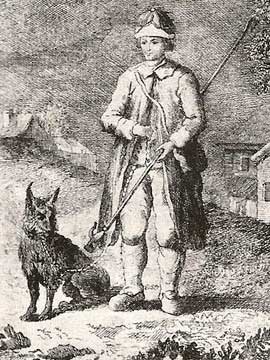 Left, an old woodcut rendition of a French shepherd with his dog shows a medium-sized dog with prick ears that resembles the Berger Picard of today.
Left, an old woodcut rendition of a French shepherd with his dog shows a medium-sized dog with prick ears that resembles the Berger Picard of today.
Dogs have been associated with the movement of livestock since pastoral nomadism and transhumance began. Old books on the shepherd's dog (e.g., von Stephanitz or Hutchinson) give accounts of much more diversity among dogs used for herding sheep and cattle than there is today, throughout the world. Why is genetic diversity important? It plays a role in the survival and adaptability of species. With more variation, it is more likely that some individuals in a population will possess genes best suited for the environment. It also serves as a way for populations to adapt to changing environments. Most breeds of dogs have been artificially selected for a particular set of looks and/or for behaviors for specific roles. This narrows gene pools. Species with very little genetic variation are at great risk. As gene pools narrow, vulnerability to diseases increases. Without genetic diversity, quite simply, a species will eventually become extinct. All dogs, however, like people, belong to the same species, and it is the most varied species of land animal in the world; so in the case of dogs, the species is unlikely to go extinct, but types and breeds could, especially types and breeds of working dogs, particularly as the jobs for which they are suited diminish. We are not privy to the future and its needs; but, just as the importance of heirloom seeds is to the diversity of food crops, diversity assures availability of role-suitable and environment-suitable types of dogs, ensuring that there will be a wide range of herding types accessible into the future.
Consider what the scene must have looked like when every isolated community had their own type of herding dogs. Herding breeds that we think of as unlike the Border Collie (e.g., the German Shepherd Dog (GSD)) had types in their heritage that were very like the old working collies. Some went extinct or are today endangered. Some do not belong to specific breeds at all, but are landrace types, a variety of domestic animal which has developed by adaptation to the natural and cultural environment in which it lives. A landrace differs from a formal breed which has been bred purposely to conform to a particular type. Landraces are commonly more genetically and physically diverse than formal breeds.
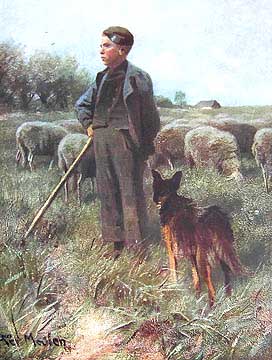 A breed is a formally recognized group of dogs genetically isolated from other groups of dogs by a breed registry, whereas, a type is a group of dogs that has never been genetically isolated in this manner. Types may share certain common characteristics (like herding ability or even herding style) but may not share others (like certain aspects of looks). Types may not have the "benefit" of a registry, but they have access to a wider gene pool limited only by geography, and today, not even limited by that. And even among certain breeds (like the Border Collie) there may also be different types. This definition may be too simplistic for the European herding dogs and the following definition may fit the bill better. It comes from Pier Vittorio Molinario, a researcher and writer in natural science and animal behavior in Italy. (I am paraphrasing because his article had to be translated by Google, and Google often misses the subtleties of a language. Furthermore, I may have misunderstood some of the context, for which I apologize.) "A breed is a group of domestic animals...that share an environment and...lifestyle of a cultural group of humans which they help to edit and modify. Even many wild animals, such as swallows and flies, share and modify their environment, but with a different degree of participation." Within breeds, by this definition, there are many types and the concept of "pure bred", which Molinario calls "one of the most disastrous things that Western culture has produced", only comes in when a registry becomes involved.
A breed is a formally recognized group of dogs genetically isolated from other groups of dogs by a breed registry, whereas, a type is a group of dogs that has never been genetically isolated in this manner. Types may share certain common characteristics (like herding ability or even herding style) but may not share others (like certain aspects of looks). Types may not have the "benefit" of a registry, but they have access to a wider gene pool limited only by geography, and today, not even limited by that. And even among certain breeds (like the Border Collie) there may also be different types. This definition may be too simplistic for the European herding dogs and the following definition may fit the bill better. It comes from Pier Vittorio Molinario, a researcher and writer in natural science and animal behavior in Italy. (I am paraphrasing because his article had to be translated by Google, and Google often misses the subtleties of a language. Furthermore, I may have misunderstood some of the context, for which I apologize.) "A breed is a group of domestic animals...that share an environment and...lifestyle of a cultural group of humans which they help to edit and modify. Even many wild animals, such as swallows and flies, share and modify their environment, but with a different degree of participation." Within breeds, by this definition, there are many types and the concept of "pure bred", which Molinario calls "one of the most disastrous things that Western culture has produced", only comes in when a registry becomes involved.
Left, "Young Shepherd" by Dutch painter Francois Pieter ter Meulen (1843-1947). The dog is a Dutch Shepherd-type, a breed extant in the Netherlands today. It resembled the many different types of Old German Shepherd Dogs (Altdeutsche Schaeferhund) that existed in the 19th century before von Stepanitz created the German Shepherd Dog (GSD) that we know today.
In both Great Britain and Ireland, and North and South America, there is no one unifying organization for all breeds of herding dogs. For European breeds, and even for some Asian breeds, there is the Fédération Cynologique Internationale (FCI), an international association of kennel clubs based in Belgium, that sets physical standards for dog breeds. The United States and Great Britain are not members of this organization, but most of the countries mentioned in these articles are, and many of the dogs mentioned are already "recognized" by the FCI. On the Continent of Europe there is still great diversity among and within herding breeds. However, as advocates of each one seeks recognition by the FCI, ostensibly as a means of protecting and preserving their breed, it cannot be stressed too strongly, diversity will be lost. Generally, when enthusiasts of a particular breed have banded together to promote and propagate that breed, they name it, form a club, and begin the process of applying for recognition by the FCI. This process usually includes defining physical characteristics that not only begin to narrow the gene pool, but tend to isolate dogs of similar type that no longer fit the now limited "standard", and push them further towards extinction. Despite my own hesitation to include breeds recognized by the FCI, some must still be mentioned, if nothing else but for their roots; for the roots of registered breeds are often the same as for non-registered breeds and types.
Please keep in mind that we are not implying that all herding breeds in Europe and Asia are cousins of the Border Collie, though some of them might be. Some of the European herding dogs, particularly those in the Alps and Pyrenees, resemble the Border Collie, but, like the Australian Shepherd and others, they work very differently. According to Alberto Bertelli, there are researchers in Europe who believe that the collie-type breeds developed in the extreme western part of Europe between northern Spain and the British Isles. If this is so, it is not yet proven by DNA analysis, and this is what it will take before many people, myself included, will accept it. However, that is not to say that European dogs did not contribute to the collie gene pool, despite the fact that these dogs did not appear in our collie family tree, or only appear there via dogs from the far distant past. European herding dogs likely developed from the same or similar stock as the Anglo Saxon, Celtic and Viking dogs, that do appear in the collie family tree, and it is possible that some hybridization did occur in both directions in the past.
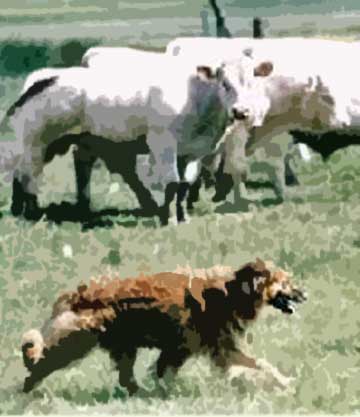 Some of the old European types still herd livestock today. They are medium-sized dogs similar to the old working collies if not precisely in looks or working style, then in diversity of looks and working styles. As mentioned before, this does not imply the infusion of working collie bloodlines from Britain. Most of the dogs presented are less well known than their larger cousins, the German Shepherd, the Belgian Shepherd, the Briard, etc., and may therefore be of greater interest. Furthermore, there are so many different herding breeds on the Continent of Europe, that it has been difficult to know how to divide them up in a way that also makes sense geographically. As I researched medium-sized herding dogs, more kept coming out of the woodwork, and I am sure there are more hiding in obscurity. Europe is heavily industrialized but there are still regions that are remote, and I may have to keep adding to these pages.
Some of the old European types still herd livestock today. They are medium-sized dogs similar to the old working collies if not precisely in looks or working style, then in diversity of looks and working styles. As mentioned before, this does not imply the infusion of working collie bloodlines from Britain. Most of the dogs presented are less well known than their larger cousins, the German Shepherd, the Belgian Shepherd, the Briard, etc., and may therefore be of greater interest. Furthermore, there are so many different herding breeds on the Continent of Europe, that it has been difficult to know how to divide them up in a way that also makes sense geographically. As I researched medium-sized herding dogs, more kept coming out of the woodwork, and I am sure there are more hiding in obscurity. Europe is heavily industrialized but there are still regions that are remote, and I may have to keep adding to these pages.
Left, a German Kuhhund with its herd. (Original photo by Kurt Stahl.)
In Eastern Europe, some countries, in particular Croatia, Hungary, Poland, and the Czech Republic, do have their own indigenous herding breeds. However, in many cases, guardian dogs often are used, and herding dogs often are not. This is the case in Russia, the Ukraine, Central Asia, and the Caucasus, where the South Russian/Ukrainian Ovcharka seems to be the dog of choice. There may have at one time been a great deal more diversity in this breed, and there may have been a herding type, but today there is not. Therefore, we will consider this particular dog in our articles on livestock guardian dogs. The herding dogs of eastern Russia and Siberia will be considered when we talk about Asia. The Kola Peninsula of Russia lies in Europe, and the Kola Sámi have a herding dog, but it is a spitz-type dog similar if not the same as the dogs used by indigenous people of Siberia, so we will look at it along with the other spitz-type dogs of Russia.
In Eastern Europe, sheep for the most part are habituated to following the shepherd or the lead sheep. Or in some cases, the shepherd simply follows the natural migration of the sheep. These countries may have had aboriginal herding breeds at one time, but borders and governments have shifted so many times that deciding which breeds belong to which countries is a difficult task. Furthermore, there is only a very little information available on sheep herding, particularly in the smaller countries, and almost no information at all on herding dogs. As we have seen, in many cases dogs are simply considered tools and not worthy of mention, except where they are recognized by a kennel club and promoted by the Dog Fancy. This is a sad situation.
However, there is Captain Max von Stephanitz (1864-1936), and through him we can see what some of the herding dogs of Eastern Europe used to be like, and what has become of them. Von Stephanitz, a German national, gained experience in biology and anatomy from serving at the Veterinary College in Berlin as a career cavalry officer, and later applied this knowledge to the breeding of dogs. At the early part of the 20th century, von Stephanitz travelled in Europe and Asia, photographing and studying the shepherds' dogs that he saw working in the various countries he visited in order to gain a perspective on what might make the best shepherd's dog. He bemoaned the fact that there did not seem to be any standardization in the herding dogs in Germany, and he wanted to develop an ideal dog that could be used everywhere. He admired dogs that had a wolfish look and prick ears, because he felt that these appeared more intelligent and worked better. He was successful in developing his own ultimate sheep dog, but the new German Shepherd Dog (GSD) was not universally accepted as the ideal of shepherds everywhere or even in Germany itself. Today, in areas where an indigenous dog still exists, many shepherds use them alongside a Border Collie. Given how ubiquitous the Border Collie has become today, perhaps von Stephanitz missed the boat when looking for the ideal shepherd's dog. Unfortunately, many of the dogs von Stephanitz saw and photographed are extinct today, and therefore his documentation of them has become all the more important.
In Asia, the lack of detailed information on many groups of people was likewise a hindrance to finding out if they used herding dogs, and if so, what they were like. For example, I might have been able to learn that they raise cattle or sheep, or breed reindeer, but their herding practices might not have been available to me. I ended up having to generalize from the small amount of information I was able to acquire. Some people living on the steppe today still breed horses and herd sheep and other livestock on horseback. These people are unlikely to need or use a herding dog, but they do have need for livestock guardian dogs or simply guard dogs for their encampments. In mountainous regions, particularly in the Caucuses, Central Asia, and Northern India, the only dogs used by pastoralists are large guardian breeds. Nevertheless, there are some pastoral groups that are associated with herding dogs, and we will examine these in the articles that follow.
One more thing we have to address, and that is the difference between herding breeds and livestock guardian breeds, which we will be adding on another page at a later time. For this, we turn to Carla Cruz, a biologist and animal scientist, who says that livestock guardian breeds possess an "absence of a well-defined predatory behavior" and that livestock guardian breeds require "a set of innate behaviors incompatible with being a good herding dog." Therefore, in places where I have defined a dog as both a herding dog and a guardian, this would be "not about predatory behavior but about territoriality".
Thanks go to the following people for their invaluable help:
Alberto Bertelli, Carla Cruz, Pier Vittorio Molinario, andLinda Rorem
Copyright © 2014 by Carole L. Presberg
Resources:
Barber, Elizabeth Wayland. The Mummies of Urumchi, W.W. Norton & Co., 2000.
Bertelli, Alberto. Department of Zoology, Parma University, Northern Italy, from private correspondence.
Cruz, Carla. A biologist, researcher, and kennel owner, from private correspondence.
Fédération Cynologique Internationale (www.fci.be).
Hutchinson, Walter. Hutchinson's Dog Encyclopaedia, "Sheepdogs & Rare Breeds," published in the 1930s by Hutchinson & CO.
La Maison de la Transhumance (www.transhumance.org).
Mallory, J.P. In Search of the Indo-Europeans: Language, Archaeology and Myth, Thames & Hudson, 1991.
Mech, L. David and Luigi Boitani. Wolves: Behavior, Ecology, and Conservation, University of Chicago Press, 2010.
Molinario, Pier Vittorio. "Il cane pastore della Valchiusella" (www.valchiusella.org/flora-e-fauna/il-cane-pastore-della-valchiusella) and from personal correspondence.
Pennisi, Elizabeth. "Ancient DNA: Old Dogs Teach a New Lesson About Canine Origins", Science, 15 November 2013 (www.sciencemag.org/content/342/6160/785.full).
Von Stephanitz, Capt. Max. The German Shepherd Dog, originally published ca. 1918 in German; 8th edition published in German in 1932; English edition of 8th edition published 1947, published by Verein fr deutsche Schferhunde.
Wikipedia:
"Gray wolf" (http://en.wikipedia.org/wiki/Gray_wolf#Hybridization_with_dogs)
"Dog" (http://en.wikipedia.org/wiki/Origin_of_the_domestic_dog)
"Eurasian Steppe" (http://en.wikipedia.org/wiki/Eurasian_Steppe)
"Scythians" (http://en.wikipedia.org/wiki/Scythians), etc.
Return to
![]()
BORDER COLLIE COUSINS
THE OTHER WEB PAGES WE MAINTAIN
These web pages are copyright ©2014
and maintained by webmeistress Carole Presberg
with technical help from webwizard David Presberg
ALL RIGHTS RESERVED
If you are interested in using ANY material on this website, you MUST first ask for permission.